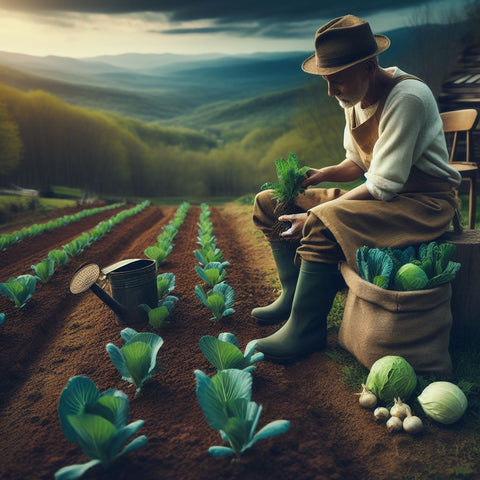Get Your Garden Ready: A Guide to Preparing and Planting Cole Crops
Introduction:
As spring approaches, garden enthusiasts eagerly anticipate the opportunity to get their hands dirty and start planting. One of the most rewarding activities during this time is preparing the garden beds and planting cole crops. Cole crops, including broccoli, cauliflower, cabbage, kale, and Brussels sprouts, thrive in cooler temperatures and are perfect additions to any home garden. In this comprehensive guide, we'll walk you through the steps to get your garden ready and successfully plant cole crops for a bountiful harvest.
Understanding Cole Crops:
Cole crops belong to the Brassicaceae family and are known for their nutrient-rich leaves and florets. These versatile vegetables are not only delicious but also packed with essential vitamins, minerals, and antioxidants. From the crisp texture of cabbage to the earthy sweetness of Brussels sprouts, cole crops offer a diverse range of flavors and culinary possibilities.

Preparing Your Garden:
Before diving into planting, it's crucial to prepare your garden beds to provide the best growing conditions for cole crops. Here are some essential steps to follow:
1. Choose a Sunny Location: Select a spot in your garden that receives full sun for at least 6-8 hours a day. Cole crops thrive in sunlight and require adequate exposure to grow and develop properly.
2. Improve Soil Quality: Cole crops prefer well-draining, fertile soil with a pH level between 6.0 and 7.0. Amend your soil with organic matter such as compost or aged manure to improve its texture, structure, and nutrient content.
3. Clear the Area: Remove any weeds, debris, or rocks from the garden bed to create a clean and open space for planting. This helps prevent competition for nutrients and ensures optimal growth for your cole crops.
4. Prepare Raised Beds (Optional): If you're planting in raised beds, ensure they are properly constructed and filled with nutrient-rich soil. Raised beds provide better drainage and allow for easier maintenance of your garden.
Planting Cole Crops:
Once your garden beds are prepared, it's time to plant your cole crops. Follow these steps to ensure successful planting and healthy growth:
1. Timing: Cole crops are cool-season vegetables that thrive in temperatures between 45°F and 75°F (7°C to 24°C). Plant them early in the spring or late in the summer for a fall harvest, avoiding the hottest months of the year.
2. Spacing: Space your cole crop plants according to their specific requirements to allow for proper air circulation and room for growth. Refer to seed packets or plant labels for recommended spacing guidelines.
3. Transplanting vs. Direct Sowing: While some cole crops, like kale and Brussels sprouts, can be directly sown into the garden, others, such as broccoli and cauliflower, are typically started indoors from seeds or transplants and then transplanted into the garden once they are well-established.
4. Watering and Mulching: Keep the soil consistently moist but not waterlogged, especially during the germination and early growth stages. Apply a layer of organic mulch, such as straw or shredded leaves, around the base of the plants to retain moisture, suppress weeds, and regulate soil temperature.
5. Fertilizing: Cole crops are heavy feeders and benefit from regular applications of balanced fertilizer throughout the growing season. Consider using organic fertilizers or compost tea to provide essential nutrients and promote healthy growth.

Pest and Disease Management:
While cole crops are relatively easy to grow, they are susceptible to certain pests and diseases that can affect their health and productivity. Here are some tips for managing common garden pests and diseases:
1. Monitor Regularly: Inspect your cole crops regularly for signs of pest damage, such as holes in leaves, chewed edges, or wilting. Early detection allows for prompt intervention and prevents infestations from spreading.
2. Practice Crop Rotation: Rotate your cole crops with unrelated plants each season to disrupt the life cycle of pests and reduce the risk of soil-borne diseases. Avoid planting cole crops in the same location year after year.
3. Use Natural Predators: Encourage beneficial insects, such as ladybugs and lacewings, to establish a presence in your garden to naturally control pest populations. Planting companion plants like marigolds, dill, and cilantro can also help repel pests and attract beneficial insects.
4. Apply Organic Controls: If pest or disease problems persist, consider using organic controls such as neem oil, insecticidal soaps, or Bacillus thuringiensis (Bt) to target specific pests while minimizing harm to beneficial organisms and the environment.
Harvesting and Enjoying Your Cole Crops:
As your cole crops mature, it's time to reap the rewards of your hard work. Here are some tips for harvesting and enjoying your freshly grown vegetables:
1. Timing: Harvest cole crops when they reach their peak maturity, typically indicated by firm heads, dense florets, or vibrant colors, depending on the specific crop. Avoid letting them become overripe or bolted, as this can affect their flavor and texture.
2. Harvesting Techniques: Use sharp garden shears or a knife to cut broccoli, cauliflower, and cabbage heads from the stem at the base of the plant. For kale and Brussels sprouts, harvest individual leaves or sprouts as needed, starting from the bottom of the plant and working upwards.
3. Storage: Store harvested cole crops in the refrigerator in perforated plastic bags or containers to maintain freshness and crispness. Use them within a few days for optimal flavor and nutritional value.
4. Cooking and Serving: Cole crops are incredibly versatile and can be enjoyed in a variety of ways, from steaming and roasting to stir-frying and sautéing. Incorporate them into your favorite recipes, such as salads, soups, stir-fries, casseroles, and side dishes, for delicious and nutritious meals the whole family will love.

Preparing and planting cole crops is a rewarding experience that allows you to enjoy a bountiful harvest of nutritious and delicious vegetables right from your own backyard. By following the steps outlined in this guide, you'll be well-equipped to create a thriving garden filled with vibrant cole crops that will delight your taste buds and nourish your body throughout the growing season. So roll up your sleeves, grab your gardening tools, and get ready to enjoy the joys of gardening and the fruits of your labor!
Happy gardening!
